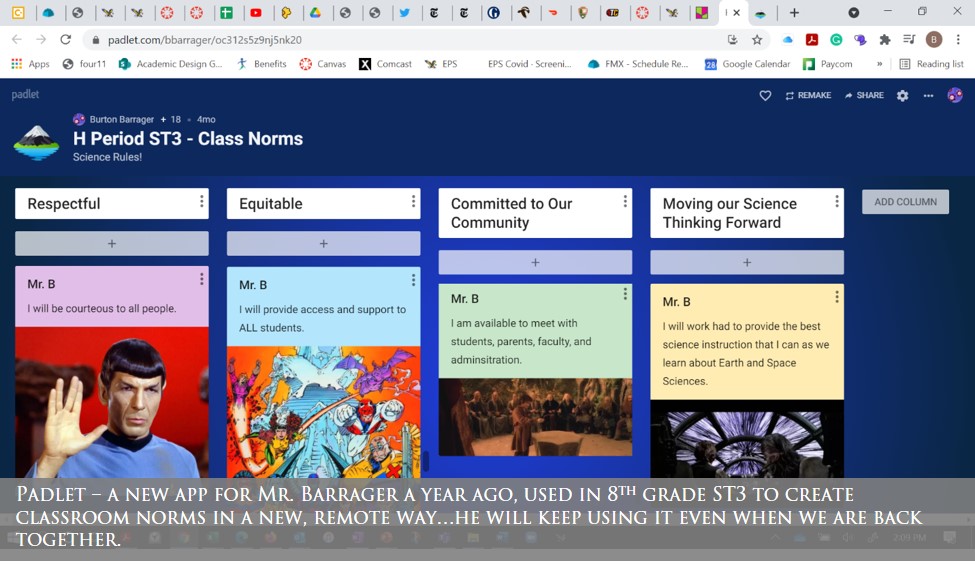
EPS Science Discipline in the Time of Remote Instruction
By Burton Barrager, 2020-21 Science Discipline Lead
I was asked, as the Science Discipline Lead, to write a reflection with this prompt: As the discipline lead, what have you seen in the process and/or progress that reinforces the EPS culture? I am not a writer I thought to myself! How was I going to complete this task!?! Well, near panic ensued as I contemplated this seemingly Herculean task. It didn’t help that I have read many articles from colleagues, especially the humanities folks, over the last 5 years of my EPS experience—truly insightful pieces, written by talented writers. I am a science person…need some data analyzed or a figure drawn of a lab set up? Then I am your guy.
After that initial reaction, I relaxed a bit and started to reflect on the sojourn of remote education that we, as individual science teachers, and as a discipline, have been on during the pandemic. Last spring, after the fateful March 2 send off, we went into triage mode as we struggled to learn new systems and teach through what ended up being the rest of the school year. Then we had time to regroup over the summer, to start planning for the fall, and reflecting on lessons learned. We knew that this mode of instruction was here to stay, for what is still proving to be an unknowable length of time, that we needed to intentionally plan and execute a quality remote science education for our students, to move past the triage mode of spring. Since then, we have all pursued various opportunities to increase our knowledge and skills in technology, as well as science specific, remote teaching methodology—this has included YouTube tutorials, identifying and teaching ourselves new apps and programs, professional university research, working closely with our highly competent and gracious technology department, tutoring and being tutored by colleagues, and participation in webinars facilitated by such organizations as the King County Green Schools Program and the National Science Teacher Association. The results, from my perspective, have been nothing short of phenomenal. Things over the course of this school year that I have been witness to in science classrooms include:
- rethinking and redesigning projects such as the 6th grade Rube Goldberg and 7th grade Cell Analogy which could be implemented completely at home, then shared electronically with other students and teachers
- streaming live dissections and stream ecology work by teachers to students at home
- performing demonstrations live using the new classroom cameras and audio gear
- creating science kits for students so they can perform guided and independent investigations and experiments at home
- purchasing, learning how to use, and integrating new apps and software programs for simulations, presentations, and student participation
- recording complex science experiments that students don’t have the materials or safety protocols for at home via phones, document cameras, camcorders, and even GoPro head-mounted cameras
- having students do animal and plant studies/observations on pets, plants, and wildlife near their home
- students designing their own experiments to be conducted at home
- students designing their own school experiments that their teacher set up for them on campus with school science equipment.
While we long for a return to “normal” or how things were, the reality is that things will never be the same for education as we knew it. I full heartedly feel that science is better taught and experienced through in-person collaboration, experimentation, and investigation…but, we have had to think differently this past year to discover and explore new methods and new technologies that work remotely, some better than what we were using before the pandemic. What new methods have we learned? What new technologies will we want to keep using? What new methods and technologies are we continuing to be exposed to and pushing to improve? These are questions that we are currently discussing in the Science Discipline.
Our students, through the challenges of remote, and now hybrid instruction, have been able to continue to experience a quality, student-focused science education through the ongoing passion, hard work, flexibility, and creativity of the Science Discipline, support of their families, and commitment from EPS leadership. I feel comfortable in making the claim that we, the whole EPS community, have continued to meet the challenge of our school Mission Statement: We inspire students to create a better world through critical thinking, responsible action, compassionate leadership, and wise innovation. We now have a whole new set of tools to work with and I, for one, am very interested to see how our science classrooms and lab spaces operate after the pandemic is over, when we will fuse what we have learned during remote and hybrid with what we did when things were “normal.”

